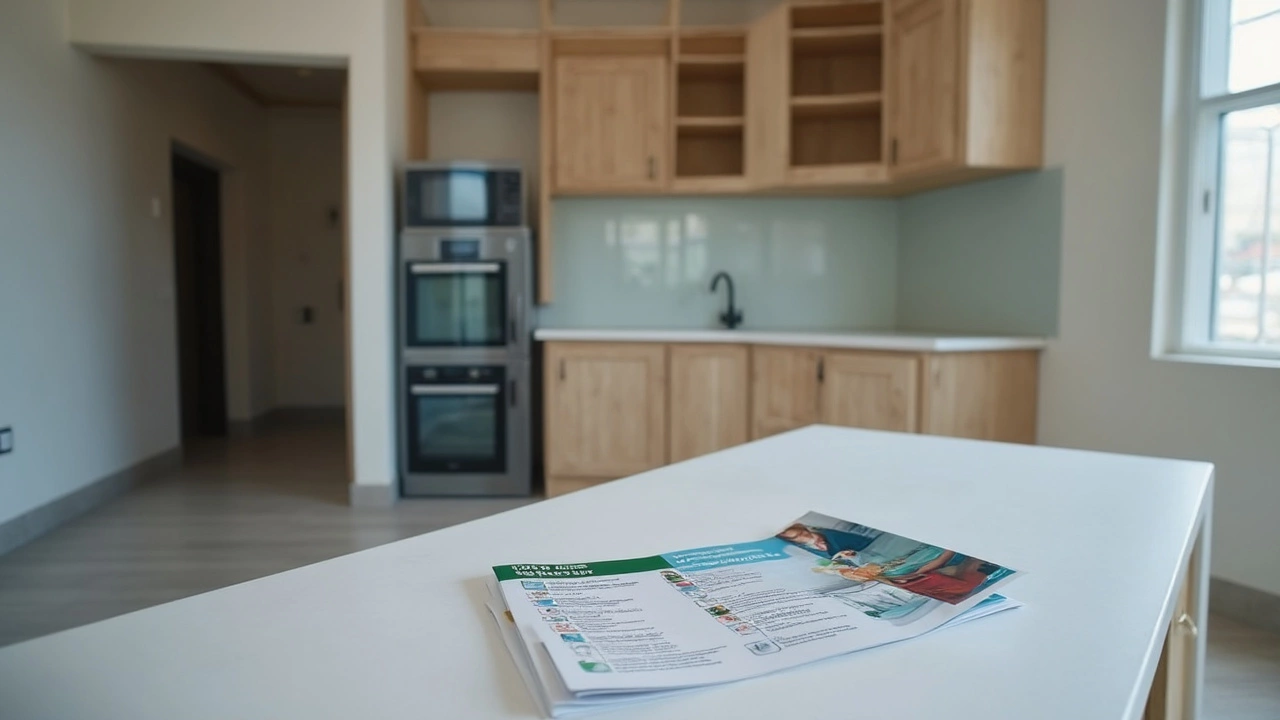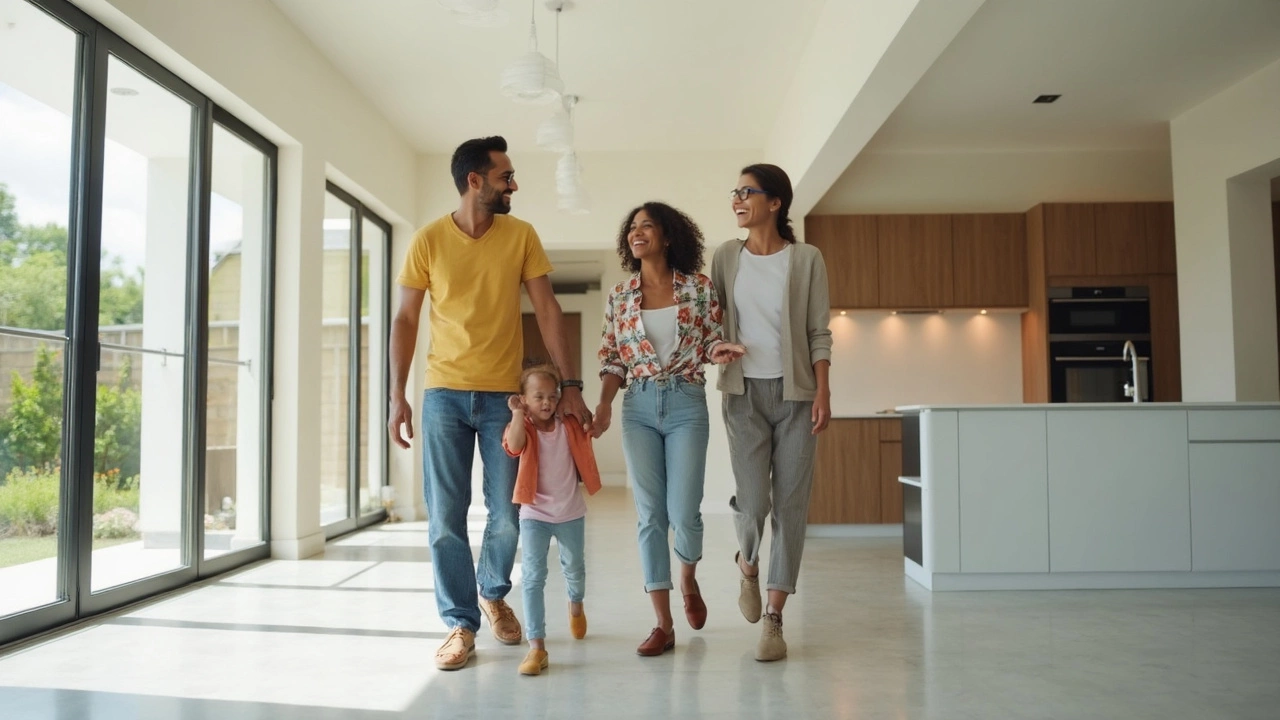Buying a new build sounds easy—brand-new house, nothing to fix, ready to move in. But the big question a lot of folks miss: what do you actually get? Not every shiny home is as plug-and-play as you’d think, and what’s included can change a lot from one builder to another.
For starters, most new builds include the essentials like plumbing, electricity, and central heating. You’ll get finished walls, basic flooring, a fitted kitchen (sometimes with appliances), and a working bathroom. But don’t just assume every part of the house is done for you. For example, some builders splash in the garden landscaping—others leave you with a patch of mud you’ll have to tackle yourself.
This stuff matters if you’re trying to figure out your true moving costs. Ever met someone who spent months living with makeshift curtains because blinds weren’t included? Or had to fork out for turf after moving in? It happens all the time. That’s why it pays to know what you’re actually getting before you start packing boxes.
- What Comes Standard with a New Build
- Common Upgrades and Extras
- What’s Usually Not Included
- How to Avoid Hidden Costs
What Comes Standard with a New Build
Most people expect a new build to come fully loaded, but what’s actually covered isn’t always obvious. Let’s clear up what you can usually count on when you buy a brand-new home.
Every new build should hit these basics:
- Finished walls and ceilings, painted in a neutral color
- Fitted kitchen cabinets and a basic set of appliances (often a stove, usually an oven, and sometimes a dishwasher or fridge—ask for the list!)
- Installed central heating, usually a modern boiler or heat pump, and all radiators or vents in place
- Complete bathroom(s), including toilets, sinks, shower or bathtub, plus tiling in key spots
- Interior doors and handles, and the front door with all locks
- Double-glazed windows for energy efficiency
- Main flooring in kitchens and bathrooms (carpet or vinyl is typical elsewhere, but upgrades cost extra)
- Lighting throughout, but expect just basic fittings or bulbs
- Electric sockets and light switches in all rooms
On the outside, you should get:
- A laid driveway or car parking space (though paving materials may vary)
- Basic pathways to the door
- Boundary fencing or garden walls—sometimes just at the back or sides
- Some kind of front landscaping, maybe turf or simple shrubs, but back gardens are often left bare
If you like numbers, check out this quick breakdown on what UK and US buyers typically find included:
| Feature | UK New Build (%) | US New Build (%) |
|---|---|---|
| Kitchen appliances (basic) | 72% | 85% |
| Finished rear garden | 38% | 56% |
| Carpet/flooring throughout | 53% | 69% |
| Window blinds/curtains | 11% | 21% |
The reality? Most things you need to live are there, but the finishing touches might not be. Always check the spec sheet and ask your builder to walk you through exactly what comes as standard—what’s on display in show homes often isn’t what you’ll actually walk into on moving day.
Common Upgrades and Extras
So here’s where things get interesting. When you check out a new build’s show home, you’re probably falling for features that aren’t part of the base price. Builders love to show off the best extras to get you hooked. But what upgrades are we really talking about?
The most popular upgrades revolve around kitchens and bathrooms. People often want better countertops, more expensive cabinet finishes, fancy splashbacks, or even a bigger fridge or dishwasher. Flooring is another area—standard carpets or laminate can be switched out for hardwood or luxury vinyl, for a price.
Hardwired alarm systems, media walls, integrated speakers, and even extra electrical outlets frequently make the upgrade wish list. Let’s not forget the garden—a patio, turf, or external lights can cost extra, but can make a big difference if you want to enjoy that space right away.
Here’s a straight-up look at common new build upgrades and the average price range you might see:
| Upgrade | Usual Cost Range (£) |
|---|---|
| Granite/Quartz Worktops | 1,500 - 3,500 |
| Underfloor Heating (Ground Floor) | 2,000 - 4,000 |
| Carpet/Flooring Upgrades | 2,000 - 6,000 |
| Integrated Kitchen Appliances | 1,000 - 3,000 |
| Fitted Wardrobes | 1,500 - 3,000 |
| Landscaped Garden | 2,500 - 7,500 |
| Extra Sockets/Lights | 100 each |
When you’re buying a new build, ask for a clear list of what’s included versus what’s an upgrade. It’s totally normal to negotiate upgrades into your deal if you reserve at the right time—sometimes the sales agent will throw in free carpets or an appliance package if you’re close to exchange. Just don’t assume anything you see in the show home comes as standard. Walk through the house with the builder’s spec sheet in your hand and double-check everything.
One last thing: builders often mark up the price of these extras more than you’d pay privately, but having everything finished for move-in can save a ton of hassle—and sometimes money if it saves ripping up brand new work later. Decide which extras matter to you most and budget for them early, so there are no surprises down the line.

What’s Usually Not Included
This is the part that catches a lot of people off guard: not everything you expect in a home comes with a new build. Builders often leave out things that you’d assume were a given—either to keep their price more competitive or to offer upgrades as extra sales.
A few things you almost always have to add on your own:
- Fencing and Landscaping: Your backyard might be just soil, and the fence could be missing or unfinished. Front garden turf may or may not be laid—always double-check the site plans.
- Window Coverings: Blinds, curtains, and hardware are typically your job. The house will have windows, but don’t count on any privacy until you put some up yourself.
- Light Fixtures: You'll usually find simple pendant bulbs in each room (if you're lucky). Actual light fittings, feature lighting, or even outdoor security lights will come out of your wallet.
- Appliances: While most offer a basic oven and hob, fridges, washing machines, and dishwashers are often upgrades, not included as standard.
- Sheds, patios, and paving: Outdoor extras are rarely thrown in for free. If the garden isn’t finished when you get the keys, budgeting for patios or garden storage is key.
- Flooring Upgrades: Some new builds offer the cheapest carpet or vinyl—if you want decent laminate, tiles, or hardwood, that’s usually an upgrade.
Let’s get concrete for a second. Here's a table showing what’s usually not included in most new builds, based on surveys from UK and US buyers in 2024:
| Item | % Not Included |
|---|---|
| Garden landscaping | 83% |
| Window coverings | 95% |
| High-end flooring | 70% |
| Garage door openers | 60% |
| Outdoor lighting | 88% |
| Major kitchen appliances (fridge, washer) | 67% |
This isn’t meant to scare you off—just to make sure you’re armed with the facts. Always get a clear list in writing from your builder, so you know what you'll need to buy or upgrade after move-in.
How to Avoid Hidden Costs
The number one complaint from folks moving into a new build? Surprise expenses popping up just after move-in day. It’s easy to get tripped up, especially if you’re getting a first home. But here’s the good news: most of the costs are avoidable if you ask the right questions and read the fine print.
First off, never assume standard means full package. Don’t just ask for a list of what’s included—ask what’s NOT. For example, some builders leave out essentials like fencing, turf, window dressings, or even light fixtures beyond basic bulbs. Before you sign anything, ask the sales rep for a point-by-point breakdown. The more detailed, the better. Pin them down in writing so you’re not left guessing.
It’s also smart to set aside a pot of cash for upgrades and items you’ll need fast. According to a UK Home Builders Federation survey in 2023, buyers on average spent an extra £4,900 fixing up new builds in their first year—stuff like carpets, driveways, or landscaping. That’s not small change.
- Get a copy of the specification list and compare it carefully to the show home. That fancy waterfall shower in the show property? Might not be standard.
- Ask exactly which appliances are included. Sometimes you only get a cooker, but you’ll need to buy a fridge and dishwasher yourself.
- Check if you’re getting basic lawn turf or if the garden comes untouched. Sod and simple fences cost more than you think.
- If you want something upgraded (maybe better tiles or spotlights), nail down the cost now. Prices jump fast after you reserve the plot.
| Item | Average extra cost (£) |
|---|---|
| Garden turf and fencing | 1,700 |
| Window blinds/curtains | 900 |
| Upgraded flooring | 1,400 |
| Lighting upgrades | 650 |
| Integrated appliances | 1,000 |
One last tip: look out for extra legal or administration fees that show up late on. Some developers add snagging retention costs or weird ‘management’ charges for green spaces. Hunt these out early. It saves a headache later, and means you’ll know the true cost of your new build from the start.

Written by Fletcher Abernathy
View all posts by: Fletcher Abernathy